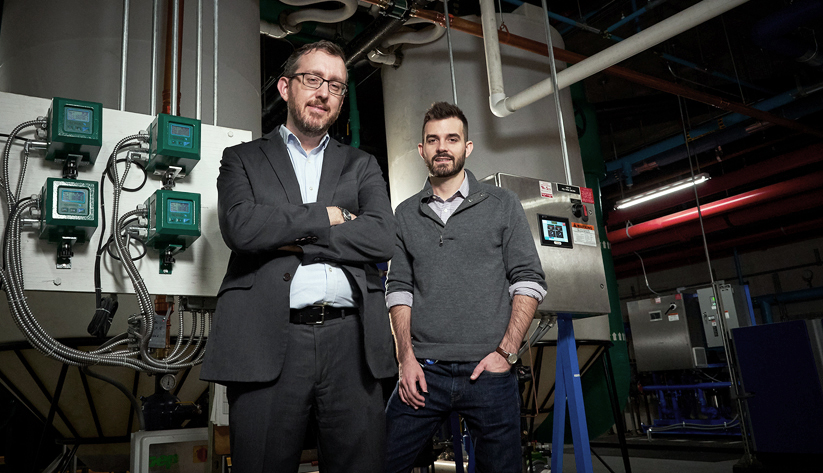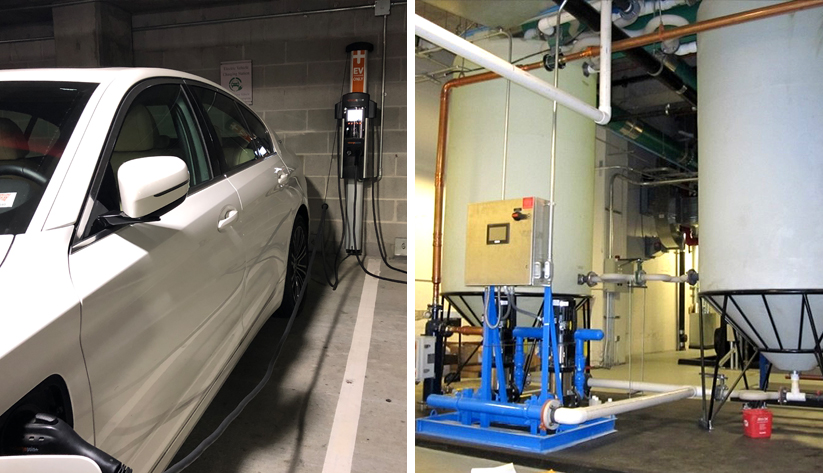
Dan Carney (left) and Brett Taysom of the Atlanta Fed. Photo by David Fine
Around the Federal Reserve Bank of Atlanta, Dan Carney and Brett Taysom are always thinking green.
The two lead the Bank's sustainability program, and their efforts have resulted in making the Atlanta Fed more environmentally friendly.
From 2009 to 2018, Bank buildings in the Sixth Federal Reserve District—which includes the Atlanta Fed head office and branch offices in Birmingham, Jacksonville, Miami, Nashville, and New Orleans—have reduced energy consumption by more than 38 percent, saving more than $1.3 million annually in utility costs. The Atlanta Fed's water usage has decreased 42 percent during that time, saving more than $83,000 a year. And of the waste generated at the Bank's offices, nearly 76 percent has been recycled or diverted from landfills, up from less than 20 percent when the program started.
Carney, a director in Facilities Management, joined the Atlanta Fed 10 years ago as an environmental program manager to implement a formal green strategy. A registered architect in the state of Georgia, Carney worked with a small group of staffers called the Green Team to develop a five-year environmental plan, initially setting goals to lower water and energy usage and conserve waste. "At the time, I was the only person at the Bank who solely focused on sustainability," Carney said.
Taking green baby steps
The green program achieved early successes from upgrading water fixtures, using rainwater and other nondrinkable water sources for irrigation, and replacing high-wattage lighting. Worn, torn, or otherwise unfit currency that the Atlanta Fed removes from circulation is shredded and sent to waste facilities that use it to generate energy for manufacturing, a better environmental practice than disposing of it in landfills. These shreds still represent a big opportunity for the Bank to recycle waste. From January through July of this year, for example, currency shreds at the Atlanta headquarters building alone came to just under 400,000 pounds.
It didn't take long to recognize that creating a sustainable environment would encompass more than water, energy, and waste savings. "We really looked at all the areas of the Bank that affect the environment," Carney said, so he considered opportunities to bolster sustainability by purchasing ecologically friendly products through Bank procurement processes, measuring environmental effects from transportation used in Bank business, and educating employees on green practices they can use at work and home.
The Facilities Management Department also upgraded the Atlanta Fed's building management software, a tool that provides real-time data on a building's energy consumption, including daily estimates of electrical use in dollars and kilowatt hours.
The significant cost savings from the decreased energy and water usage has impressed management, Carney said. The power bill alone has dropped by almost two-thirds since Carney came to the Bank. "This reduction would not have been possible without the efforts of a lot of people throughout Facilities Management, from our project managers who complete mechanical upgrade projects to the building operations team that continues to drive efficiency in how we operate our building day to day."
Management came to realize that those cost savings could fund other Bank needs. "Through our conscious efforts to reduce electricity consumption, we have freed up capital to use on other infrastructure projects, such as elevators and critical building equipment like generators," Carney said. "Shrinking that utility budget can really have an impact."
Going to greener levels
Taysom was hired in 2015 to broaden the sustainability program with more employee engagement efforts. An environmental scientist by training, Taysom expanded the reporting of the Bank's energy usage and water and waste recycling efforts. He also worked with Green Team members to develop more employee initiatives. Taysom managed the effort to attain LEED (Leadership in Energy and Environmental Design) Platinum certification for the Atlanta Fed headquarters, a feat achieved last year. LEED is a building certification process developed by the nonprofit U.S. Green Building Council.

An electric vehicle charging station and water reclamation tank, examples of the Atlanta Fed's sustainability efforts.
The head office building in Midtown Atlanta attained LEED Gold designation in 2013, but reaching Platinum, the highest certification level, required more improvements. "We had to start tracking our data on a more granular basis," said Taysom, who had worked on LEED projects in a prior job with a real estate investment company. The Bank took on initiatives including upgrading lights to more efficient LED devices and adopting sustainable purchasing policies. The Atlanta Fed also examined every piece of its equipment, from huge chillers to small air vents, and recalibrated them when necessary to ensure efficient operation.
Achieving Platinum certification also required a commuter survey to determine how many Atlanta Fed employees used mass transit, and the Bank had to ensure that it was using the right kinds of chemicals in cleaning and pest control. "Working on LEED certification is like being a middleman. You're working with vendors, in-house staff, and consultants and just making sure that everyone is on the same page," said Taysom. The Atlanta Fed successfully achieved Platinum certification in the fall of 2018.
The Atlanta Fed's branch offices have also gained awards and recognition. For example, the Jacksonville, Miami, New Orleans, and Birmingham branches have earned the BOMA360 (Building Owners and Managers Association) certification, signifying that they exceed best practices for environmental sustainability, law enforcement, and community outreach. CNN featured the New Orleans Branch in a 2016 feature explaining how shredded currency is recycled into compost that nourishes soil for planting.
"The Bank is definitely trying to be a leader from a sustainability perspective," said Mason Moore, a Facilities and Support Services manager in the New Orleans Branch who is a member of the Green Team. "We are continually working on the areas that are obvious—reducing water and energy, moving to less-toxic pest controls—and we are now looking for ways to further the program."
Technology is under development that will offer ways to derive even more sustainability gains, Carney said. For example, analytics tools embedded into the building management software will be able to track data from each piece of equipment in every office in the Atlanta Fed's district. Among other things, these data will indicate when something has been running unnecessarily or if the efficiency of a piece of equipment is gradually diminishing. Already at the Atlanta headquarters, a control room, with sophisticated screens displaying various graphics, keeps tabs on the building's environmental data.
"The predictive aspects of this are exciting, and that's the future," Carney said. "That software will let our facilities teams at each branch optimize the performance of their building and make sure we maintain the gains that we've seen."
Taysom said he remains motivated as the Bank explores new sustainability certification programs. He said the Bank is evaluating how it can contribute to the United Nations Sustainable Development Goals, which promote local efforts to advance 17 worldwide objectives, including water and energy savings but also much more, such as providing decent work and economic growth for all, reducing inequalities among races and genders, and creating more sustainable cities and communities.
"It's a way to expand the definition of sustainability beyond just facilities," Taysom said. "We're realizing that sustainability is a connection between people, planet, and profit/equity. If you can make all three of those things strong, it's easier to have less of a negative impact on the environment."




